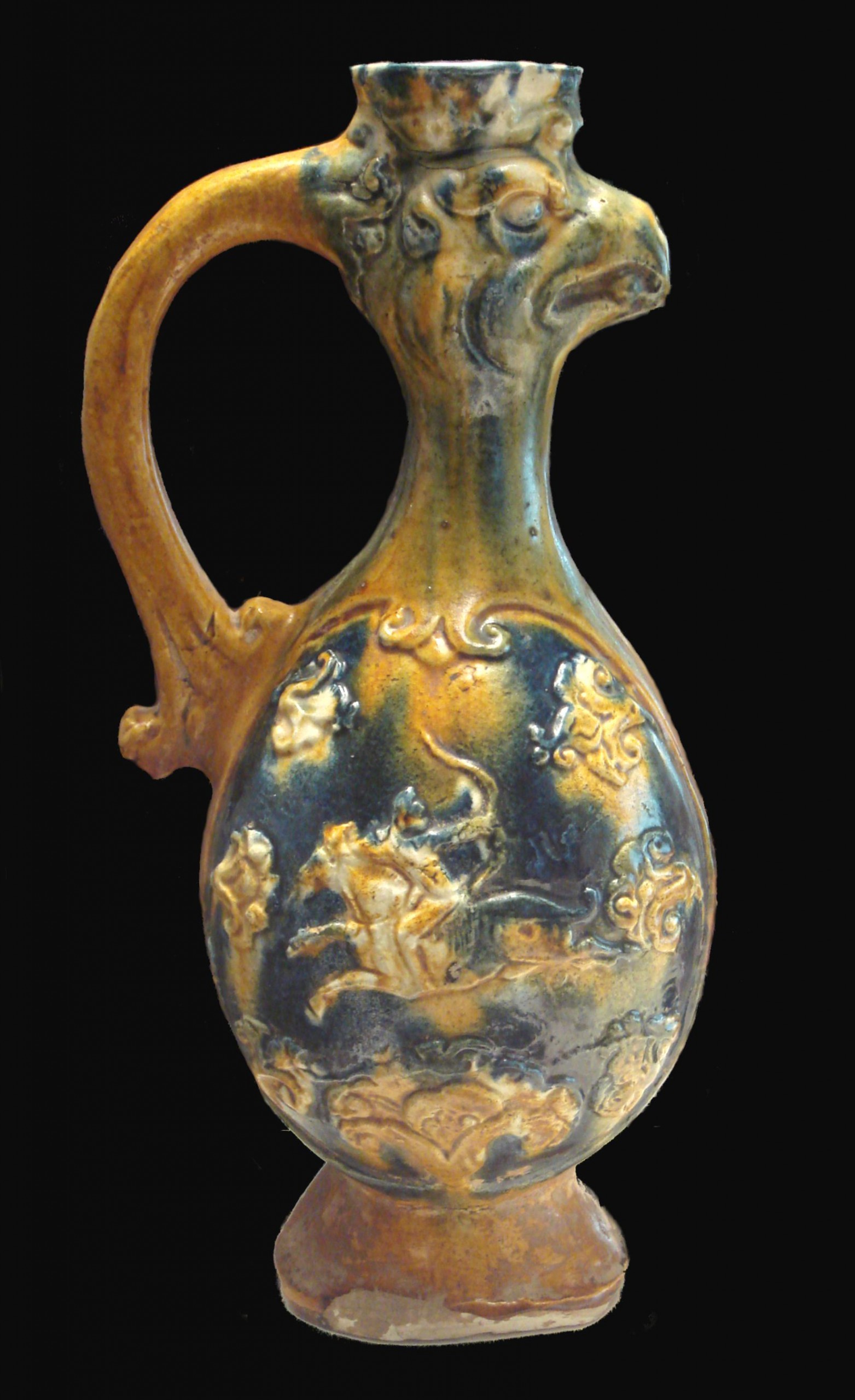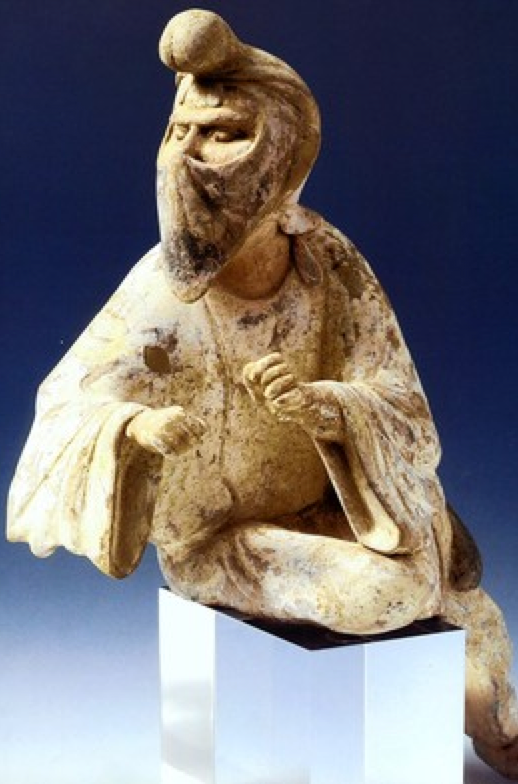The posting below is from Matteo Compareti’s article “The last Sassanians in China” which was originally published in the Encyclopedia Iranica on July 20, 2009.
Kindly note that a number of pictures displayed in the Compareti article below are from Kaveh Farrokh’s lectures at the University of British Columbia’s Continuing Studies Division , Stanford University’s WAIS 2006 Critical World Problems Conference Presentations on July 30-31, 2006 and Farrokh’s textbook Shadows in the Desert: Ancient Persia at War-Персы: Армия великих царей-سایههای صحرا-).
Readers are also referred to the following resources:
- Frank Wong: Pirouz in China: Defeated Persian army takes refuge (CAIS)
- The Shahrbaraz Blog: –حضور ایرانیان در چین-The presence of Iranians in China
==========================================================================
Information on those Sasanians who avoided the submission to the Arabs and lived in Central Asia or at the Tang court can be found in the works of Muslim authors and in Chinese sources. According to Masʿudi, Yazdegerd III (r. 632-51) had two sons, Wahrām and Peroz, and three daughters, Adrag, Šahrbānu, and Mardāwand (Maçoudi, II, p. 241; see also Christensen, p. 508; Amir-Moezzi, pp. 255-56). As Balāḏori recorded, Peroz settled among the Turks of Ṭoḵārestān and even married a noble Turkish woman (Hitti, p. 493).
Some further data can be deduced from Chinese sources, especially the Jiu Tangshu (‘Old History of the Tang,’ completed in 945) and the Xin Tangshu (‘New History of the Tang,’ composed in 1060). The two chronicles are roughly the same, although some details can vary: the section regarding the history of Peroz (called Bilusi) is quite different in them. According to the Jiu Tangshu, Peroz was captured by the Turkish prince of Ṭoḵārestān while escaping from the Arabs. Later he could elude his Turkish warders and, in the years 661-62, he sent an embassy to the Tang emperor Gaozong (r. 650-83), asking for military support against the Arabs. After the defeat of the Western Turks between 657 and 659, the Chinese were organizing their protectorate in the territories just conquered. The city of Zaranj in Sistān became the capital of that province, and Peroz was recognized as its governor. Peroz sent several embassies to China, and during 670-74 he personally arrived at the Tang court. Gaozong received him warmly and accorded to him the title of ‘General of the Right Militant Guard.’ In 678-9 he ordered Pei Xingjian to take Peroz back to Persia with the support of a military contingent. However, upon arriving at Suyāb/Ak Beshim, Pei Xingjian remained there and abandoned Peroz. The latter could stay for approximately twenty years in Ṭoḵārestān fighting the Arabs but, later, “the people of his tribe got dispersed” (Daffinà, p. 133). In 708-9 Peroz went back to the Tang capital and was proclaimed ‘General of the Left Majestic Guard.’ Eventually, he died from a disease, and his reign finished, although Chinese chronicles reported the arrival of Persian embassies for a while. The information of the Xin Tangshu appears more reliable. This source states that Peroz found shelter in Ṭoḵārestān, but he did not receive any support from Gaozong. He established himself in Sistān with the help of the rulers of Ṭoḵārestān during a temporary slowdown in the Arab advance. In 661-64 Peroz sent several embassies to the Chinese court requesting Tang intervention against the Arabs, but he could only manage to be recognized in 661 as the head of the ‘Persian Area Command’ (Bosi dudufu), whose capital was Zaranj. In 662 Gaozong accorded to him the title of ‘King of Persia’ (Bosi wang), so for this reason he should be regarded as Peroz III, since Peroz II ascended the Sasanian throne for a very short time after Khosrow II (r. 591-628) and even struck his own coins (Gurnet, pp. 291-94; Bosworth, pp. 408, 411). Later, around 663, the Arabs could defeat him, and Peroz III himself arrived at the Chinese capital Chang’an between 673 and 674, and then again in 675, being warmly received by Gaozong on both occasions. He also got the title of ‘General of the Right Militant Guard.’ It is further recorded that, in 677, Peroz asked permission from Gaozong to build a “Persian temple” (Bosi si) which should be considered a Christian church (Leslie, pp. 283, 286-88; Forte, 1996a, pp. 355, 364). Syro-Oriental Christians were particularly numerous within the domains of the late Sasanians, and it is worth noting that Yazdegerd III’s funeral service would have been accomplished by the bishop of Merv. Moreover, according to a later tradition, his wife would have been Christian (Scarcia, 2004, p. 121). One should also mention Aluoben (Abraham?), a man of Persia who introduced Christianity into China and built the first church at Chang’an (Forte, 1996a, pp. 349-74; Idem, 1996b, pp. 375-428; Tajadod, pp. 43-45). According to an inscription on a Christian stele from Xi-an, another Persian named Li Su (he died in 817) was a clergyman and a member of the Sasanian family (Ge and Nicolini-Zani, p. 181). [Click to Enlarge] The above figure is from a Tang dynasty burial site, now housed now at the museum at Turin, Italy. Curators and scholars continue to debate the figure’s origins; one possibility is that he was of Iranian descent (Picture source: The Wall Street Journal). Now it is a well-known fact that there were very strong connections between the late Sasanian rulers and the Christians, whose status was definitely better than during the early Sasanian period (Mango, pp. 111, 115-18; Scarcia, 2000, p. 190; Idem, 2004, pp. 117-35; Panaino, pp. 843-62; Tubach, Arafa, and Vashalomidze). Peroz died possibly around 679, and his statue—unfortunately beheaded but recognizable by a Chinese inscription on the back of its pedestal—still embellishes the monumental tomb of Gaozong and his wife at Qiangling near Xi’an. At the same site, according to a Chinese inscription on its back, there is also the mutilated statue of Nanmei, the ‘Grand Head of Persia’ (Bosi da shouling), but nothing precise is known about him. Possibly, he was one of those Persian aristocrats who followed Peroz in China and held important positions at his court and, so, he could have been a member of the Sasanian family too (Forte, 1996b, p. 404; Idem, 1996c, pp. 191-92). The same Chinese chronicle also informs about Peroz’s son, Narseh (called in Chinese sources Ninieshi, Ninieshishi, Nihuanshi, Nilishishi, Nihuangshishi, Nimishi, or Nilishishi), who was a hostage at the Tang court. He is said to have accompanied the Chinese general Pei Xingjian in order to rescue Persia from the Arabs around 679. However, during the crossing of the Turkish territory, in nowadays Kirghizstan, the Chinese general conquered the city of Suyāb/Ak Beshim, taking the Turks and their Tibetan allies by surprise. So, Pei Xingjian left Narseh to regain the throne of Ctesiphon alone, since his true mission had been accomplished. Recent archaeological investigations at Ak Beshim confirmed some of the information in the Chinese sources (Lubo-Lesnichenko, p. 117). The true intentions of the Chinese general could be considered as accurate planning by the Tang court, because the Chinese had had diplomatic exchanges with the Arabs too at least since 651 (Petech, pp. 621-22). In fact, Narseh could never reach proper Persia and fought for twenty years against the Arabs being supported by Turkish lords of Ṭoḵārestān, like his father. A Chinese document discovered in the beginning of 20th century at Astana, near Turfan, makes mention of a so-called ‘Persian army’ (Bosi jun), which crossed the territory of Chinese Turkistan between 677 and 681 (Maspero, pp. 95-97). Possibly, this event could be identified with the passage of Narseh on his way to reestablish the Sasanian dynasty (Jiang, pp. 38-45). After the failure of his attempt to re-conquer Persia, Narseh went back to China around 707-9, to live the rest of his days as a respected member of the Tang court, and died from a disease. The Tang emperor accorded to him the title of ‘General of the Left Majestic Guard.’ The Xin Tangshu reports (see Chavannes, p. 173; Daffinà, p. 135) that only the western part of his territory was not invaded by the Arabs (even though this looks rather enigmatic, since the Arabs were coming from the west). The same source also says that embassies coming from a country considered by the Chinese to be Persia continued to arrive at Chang’an until 755. It was proposed to recognize this country as Māzandarān or, most likely, Ṭoḵārestān, where the Arabs arrived later (Chavannes, pp. 173-4; Daffinà, p. 139; Compareti, p. 211), although at least on one occasion, an embassy reached Chang’an in 751 from a kingdom to be likely identified with Surestān in southern Mesopotamia (Daffinà, p. 138). This was actually a territory in the western part of Persia, and Mani too was said to be originally from Surestān, although on this point the Chinese sources are enigmatic (Palumbo, pp. 307-10). In the Jiu Tangshu there is a considerable confusion between the figures of Peroz and Narseh, while in the Xin Tangshu it is clearly stated that after 679 it was Narseh who fought in Ṭoḵārestān against the Arabs, as already argued by some scholars on the basis of the age of Peroz (Drake, pp. 6-7). According to Herzfeld (p. 94), Peroz was born in 636, a date which could be considered well-fitting for the general history of late Sasanians and for the events narrated in the Chinese chronicles. There then arises another question regarding the military position of Peroz as described in the Jiu Tangshu: why, in fact, should Gaozong have accorded to him two different titles? Some other Persians are recorded in Chinese sources as military or relevant people well received at the court, but their affiliation to the Sasanian family is not proved (Harmatta, pp. 375-76; Daffinà, pp. 136-39; Forte, 2000, pp. 183-85). It was argued that some of the men from Ṭoḵārestān, who arrived in Japan between 654 and 660, could have been members of the Sasanian family, but, once again, this is just a hypothesis (Itō, pp. 60-62). A funerary stele, which was recovered near Luoyang (not far from Xi’an), revealed important information regarding the career of Aluohan, a man of Persia highly esteemed by Gaozong and a contemporary of Peroz, who was even sent to Byzantium as a Chinese envoy and died in 710. Suggestions have been made to identify him with Peroz’s brother, Wahrām, with good argumentation from the point of view of both the Chinese sources (Forte, 1984, pp. 174-80; Idem, 1996c, pp. 193-94) and the Mazdean apocalyptic texts, where he was celebrated in a small poem entitled ‘On the Coming of the Miraculous Wahrām’ (Abar Madan ī Wahrām ī Warzāwand; see Cereti, pp. 635-38; cf. Sprengling, pp. 175-76). His son’s name, Ju Luo, could be probably reconstructed as Khosrow according to the pronunciation of the Tang period. For this reason, he was associated with a certain Khosrow, a descendant of Yazdegerd III, who tried to re-conquer the Sasanian empire in 728-29 with the support of Turkic contingents (Forte, 1996c, pp. 193-94; cf. Harmatta, p. 375), as recorded in the Chinese and Muslim sources (Chavannes, pp. 173, 258; Christensen, p. 509). Many Persians lived undisturbed in China due to the attitude of the first Tang emperors, but the situation changed after the An Lushan rebellion in 755-6 and, especially, with the edicts issued by the Taoist minister Li Mi (722-89) aimed to stop the monetary support granted to foreign nobles living at Chang’an (Dalby, p. 593). Bibliography M. A. Amir-Moezzi, “Shahrbānū, princesse sassanide et épouse de l’Imam Husayn. De l’Iran préislamique à l’Islam shiite,” Comptes Rendus de l’Académie des Inscriptions et Belles Lettres 1, 2002, pp. 255-85. C. E. Bosworth, The History of al-Tabarī (Ta’rīkh al-rusul wa’l-mulūk), vol. V: The Sāsānids, the Byzantines, the Lakhmids, and Yemen, tr. and annot. C. E. Bosworth, New York, 1999. C. G. Cereti, “Again on Wahrām ī Warzāwand,” in La Persia e l’Asia Centrale da Alessandro al X secolo, Rome, 1996, pp. 629-39. E. Chavannes, Documents sur les Tou-Kieu (Turks) Occidentaux, Paris, 1903. A. Christensen, L’Iran sous les Sassanides, Copenhagen, 1944. M. Compareti, “The Last Sasanians in China,” Eurasian Studies 2/2, 2003, pp. 197-213. P. Daffinà, “La Persia sassanide secondo le fonti cinesi,” Rivista degli Studi Orientali 57, 1983, pp. 121-70. M. T. Dalby, “Court Politics in late Tang Times,” in The Cambridge History of China, vol. III: Sui and T’ang China, 589-906, pt. 1, ed. D. Twitchett, Cambridge, 1979, pp. 561-681. F. S. Drake, “Mohammedanism in the Tang Dynasty,” Monumenta Serica 8, 1943, pp. 1-40. A. Forte, “Il persiano Aluohan (616-710) nella capitale cinese Luoyang, sede del Cakravartin,” in Incontro di religioni in Asia tra il III e il X secolo d. C., ed. L. Lanciotti, Florence, 1984, pp. 169-98. Idem, “The Edict of 638 Allowing the Diffusion of Christianity in China,” in P. Pelliot, L’inscription nestorienne de Si-Ngan-Fou, ed. A. Forte, Kyoto and Paris, 1996a, pp. 349-74. Idem, “On the So-Called Abraham from Persia. A Case of Mistaken Identity,” in P. Pelliot, L’inscription nestorienne de Si-Ngan-Fou, ed. A. Forte, Kyoto and Paris, 1996b, pp. 375-428. Idem, “On the Identity of Aluohan (616-710). A Persian Aristocrat at the Chinese Court,” in La Persia e l’Asia Centrale da Alessandro al X secolo, Rome, 1996c, pp. 187-97. Idem, “Iraniens en Chine. Buddhisme, mazdéisme, bureaux de commerce,” in La Sérinde terre d’échanges, ed. J.-P. Drège, Paris, 2000, pp. 181-90. Ge Chenyong and M. Nicolini-Zani, “The Christian Faith of a Sogdian Family in Chang-an during the Tang Dynasty,” AIUON 64, 2004, pp. 181-96. F. Gurnet, “Une drachme sassanide de Pērōz II,” Stud. Ir. 24/2, 1995, pp. 291-94. J. Harmatta, “The Middle Persian-Chinese Bilingual Inscription from Hsian and the Chinese-Sāsānian Relations,” in La Persia nel Medioevo, Rome, 1971, pp. 363-76. E. Herzfeld, “Khusrau Parwēz und der Tāq i Vastān,” AMI 9, 1938, pp. 91-158. P. K. Hitti, The Origins of the Islamic State. Being a Translation from Arabic Accompanied with Annotations Geographic and Historic Notes of the Kitâb Futûh al-Buldân of al-Imâm abu-l ‘Abbâs Ahmad ibn-Jâbir al-Balâdhuri, vol. I, New York, 1916, repr. in 1968. G. Itō, “Zoroastrians’ Arrival in Japan (Pahlavica I),” Orient 15, 1979, pp. 55-63. Jiang Boqin, Dunhuang and Turfan Documents Concerning the Silk Road, Beijing, 1994 (in Chinese). D. D. Leslie, “Persian Temples in T’ang China,” Monumenta Serica 35, 1981-83, pp. 275-303. E. I. Lubo-Lesnichenko, “Svedeniya kitaĭskikh pis’mennykh istochnikov o Suyabe (gorodishche Ak-Beshim)” (Data in Chinese Written Sources on Suyab [Settlement of Ak-Beshim]), in Suyab Ak-Bešim, St. Petersburg, 2002, pp. 115-27. Maçoudi. Les prairies d’or, ed. and tr. C. Barbier de Meynard and P. de Courteille, 9 vols., Paris, 1861-77. C. Mango, “Deux études sur Byzance et la Perse sassanide. I. Héraclius, Šahrvaraz et la Vraie Croix,” Travaux et Mémoires 9, 1985, pp. 91-118. H. Maspero, Des documents chinois de la troisième expédition de Sir Aurel Stein en Asie Centrale, London, 1953. A. Palumbo, “Mani in Cina,” in Il Manicheismo, vol. I: Mani e il Manicheismo, ed. G. Gnoli, Roma, 2003, pp. 279-316. A. Panaino, “La chiesa di Persia e l’impero sasanide. Conflitto e integrazione,” in Cristianità d’Occidente e Cristianità d’Oriente (secoli VI-XI), Spoleto, 2004, pp. 765-863. L. Petech, “Le ambasciate arabe in Cina,” in Studi in onore di Francesco Gabrieli nel suo ottantesimo compleanno, ed. R. Traini, vol. II, Rome, 1984, pp. 619-30. G. Scarcia, “Cosroe Secondo, San Sergio e il Sade,” Studi sull’Oriente Cristiano 4/2, 2000, pp. 171-227. Idem, “La «sposa bizantina» di Khosrow Parviz,” in La Persia e Bisanzio, Rome, 2004, pp. 115-35. M. Sprengling, “From Persian to Arabic,” AJSLL 56/2, 1939, pp. 175-213. N. Tajadod, À l’est du Christ. Vie et mort des chrétiens dans la Chine des Tang (VIIᵉ-IXᵉ siècle), Paris, 2000. J. Tubach, M. Arafa, and G. S. Vashalomidze, Die Inkulturation des Christentums im Sasanidenreich, Wiesbaden, 2006.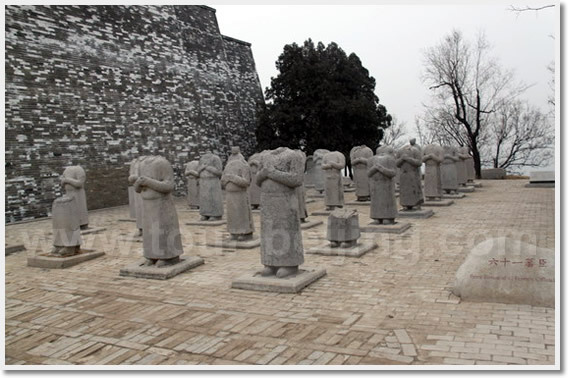 Visitors to the tomb of Emperor Gaozong (r. 649-683 CE) of the Tang dynasty (618-907 CE) will see that one of the statues guarding the emperor as depicted above has the name of Sassanian prince Peroz (d. 679 CE) (Picture source: Tour Beijing). Peroz was crowned in China after the Arab invasion which toppled the Sassanian Empire in 637-651 CE. There is a tomb and statue in China which bears this inscription: Peroz, Shah of Iran, crowned in Tang dynasty court: Commander-in-chief of Iranian Army, Martial General of the Right
Visitors to the tomb of Emperor Gaozong (r. 649-683 CE) of the Tang dynasty (618-907 CE) will see that one of the statues guarding the emperor as depicted above has the name of Sassanian prince Peroz (d. 679 CE) (Picture source: Tour Beijing). Peroz was crowned in China after the Arab invasion which toppled the Sassanian Empire in 637-651 CE. There is a tomb and statue in China which bears this inscription: Peroz, Shah of Iran, crowned in Tang dynasty court: Commander-in-chief of Iranian Army, Martial General of the Right
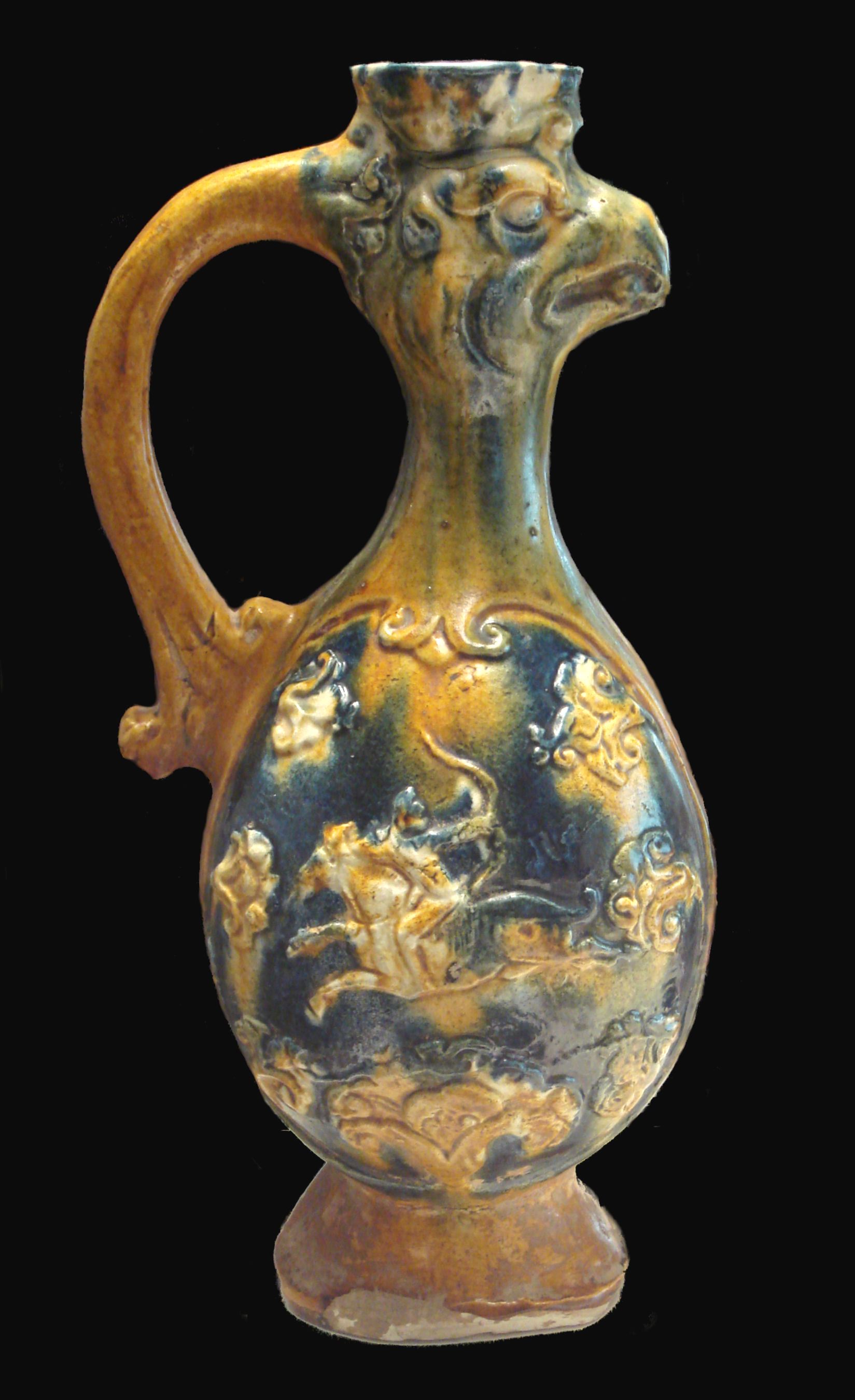 [Click to Enlarge] A well-preserved Tang vase (8-9th century CE)housed at the Guimet Museum. This bears distinct Sassanian artistic influences.
[Click to Enlarge] A well-preserved Tang vase (8-9th century CE)housed at the Guimet Museum. This bears distinct Sassanian artistic influences.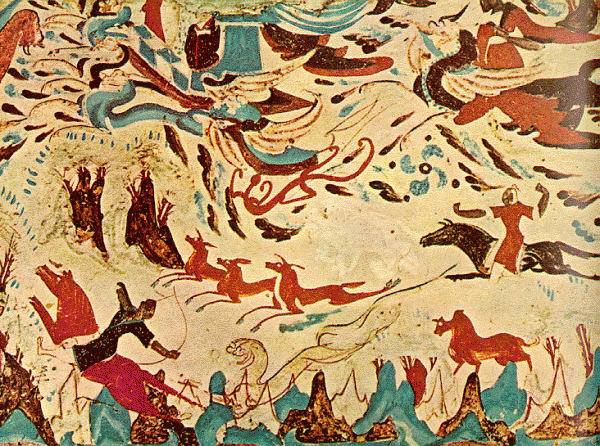 [Click Picture to Enlarge] Chinese noblemen engaged in horse-archery during the hunt against lions. Parthian horses and cavalry styles profoundly affected China (see Farrokh, Shadows in the Desert: Ancient Persia at War-Персы: Армия великих царей-سایههای صحرا-, 2007, pp. 170-171).
[Click Picture to Enlarge] Chinese noblemen engaged in horse-archery during the hunt against lions. Parthian horses and cavalry styles profoundly affected China (see Farrokh, Shadows in the Desert: Ancient Persia at War-Персы: Армия великих царей-سایههای صحرا-, 2007, pp. 170-171).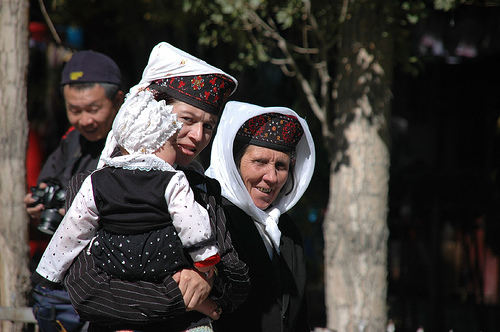 Iranian-speaking Tajik women from China. These are mainly clustered in the Karakorum region.
Iranian-speaking Tajik women from China. These are mainly clustered in the Karakorum region.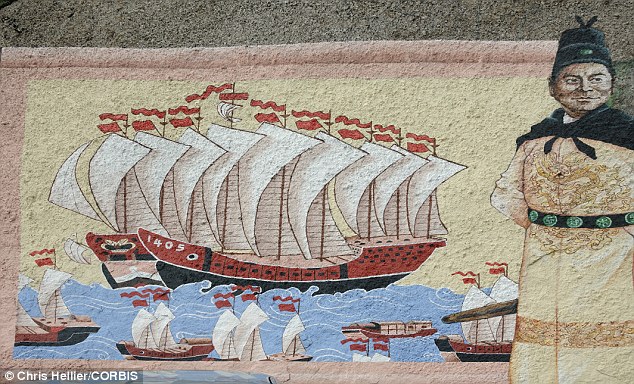 Chinese Admiral Zheng He who was of Persian descent. Zheng He is recognized for having sailed with his giant fleet to Europe and Africa. (Source: Chris Heller/CORBIS & The Mail).
Chinese Admiral Zheng He who was of Persian descent. Zheng He is recognized for having sailed with his giant fleet to Europe and Africa. (Source: Chris Heller/CORBIS & The Mail).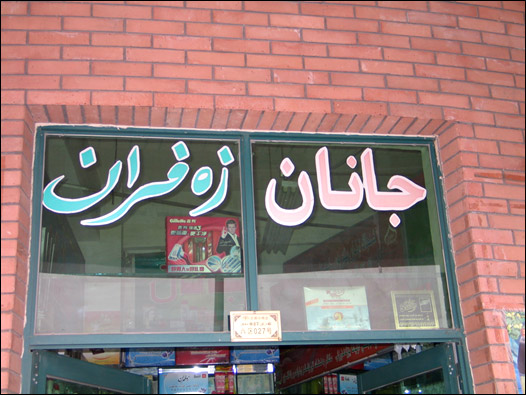 Shop with modified Persian script in Kashgar, northwest China. This is one of the legacies of the historical silk route straddling between ancient Iran and China, having its origins in the pre-Islamic era and enduring well into the post-Islamic era. The shop sign reads “Jaanan Zaaferan” or Jaanan’s saffron.
Shop with modified Persian script in Kashgar, northwest China. This is one of the legacies of the historical silk route straddling between ancient Iran and China, having its origins in the pre-Islamic era and enduring well into the post-Islamic era. The shop sign reads “Jaanan Zaaferan” or Jaanan’s saffron.

